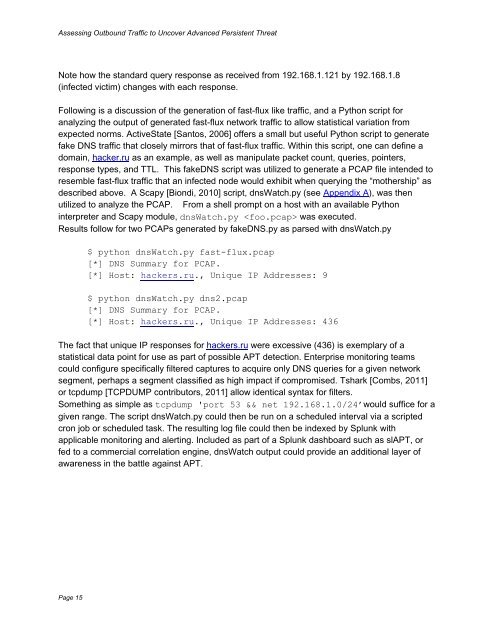JWP-Binde-McRee-OConnor
JWP-Binde-McRee-OConnor
JWP-Binde-McRee-OConnor
Create successful ePaper yourself
Turn your PDF publications into a flip-book with our unique Google optimized e-Paper software.
Assessing Outbound Traffic to Uncover Advanced Persistent Threat<br />
Note how the standard query response as received from 192.168.1.121 by 192.168.1.8<br />
(infected victim) changes with each response.<br />
Following is a discussion of the generation of fast-flux like traffic, and a Python script for<br />
analyzing the output of generated fast-flux network traffic to allow statistical variation from<br />
expected norms. ActiveState [Santos, 2006] offers a small but useful Python script to generate<br />
fake DNS traffic that closely mirrors that of fast-flux traffic. Within this script, one can define a<br />
domain, hacker.ru as an example, as well as manipulate packet count, queries, pointers,<br />
response types, and TTL. This fakeDNS script was utilized to generate a PCAP file intended to<br />
resemble fast-flux traffic that an infected node would exhibit when querying the ―mothership‖ as<br />
described above. A Scapy [Biondi, 2010] script, dnsWatch.py (see Appendix A), was then<br />
utilized to analyze the PCAP. From a shell prompt on a host with an available Python<br />
interpreter and Scapy module, dnsWatch.py was executed.<br />
Results follow for two PCAPs generated by fakeDNS.py as parsed with dnsWatch.py<br />
$ python dnsWatch.py fast-flux.pcap<br />
[*] DNS Summary for PCAP.<br />
[*] Host: hackers.ru., Unique IP Addresses: 9<br />
$ python dnsWatch.py dns2.pcap<br />
[*] DNS Summary for PCAP.<br />
[*] Host: hackers.ru., Unique IP Addresses: 436<br />
The fact that unique IP responses for hackers.ru were excessive (436) is exemplary of a<br />
statistical data point for use as part of possible APT detection. Enterprise monitoring teams<br />
could configure specifically filtered captures to acquire only DNS queries for a given network<br />
segment, perhaps a segment classified as high impact if compromised. Tshark [Combs, 2011]<br />
or tcpdump [TCPDUMP contributors, 2011] allow identical syntax for filters.<br />
Something as simple as tcpdump 'port 53 && net 192.168.1.0/24’would suffice for a<br />
given range. The script dnsWatch.py could then be run on a scheduled interval via a scripted<br />
cron job or scheduled task. The resulting log file could then be indexed by Splunk with<br />
applicable monitoring and alerting. Included as part of a Splunk dashboard such as slAPT, or<br />
fed to a commercial correlation engine, dnsWatch output could provide an additional layer of<br />
awareness in the battle against APT.<br />
Page 15










